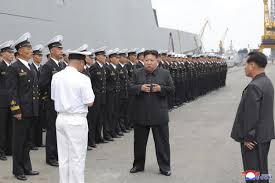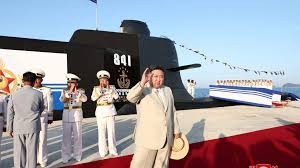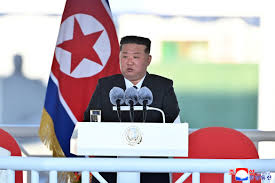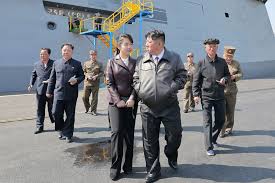Kim Jong Un Orders Navy Readiness Amid Tensions IN 2025
Kim Jong Un Orders Navy Readiness Amid Tensions 2025 recent months, Kim Jong Un, Supreme Leader of North Korea, has ordered the People’s Navy to raise its readiness levels amid increased geopolitical friction. This move has drawn regional and international attention, as analysts assess its motives, capabilities, and likely consequences. With North Korea’s evolving naval modernization, missile tests, and security posture shifts, the directive could signal strategic deterrent posturing or preparation for possible escalation.
This article provides a detailed,tailored report on the order, the context behind it, the capabilities at play, regional responses, and what to watch going forward.

Kim Jong Un Orders Navy Readiness Amid Tensions 2025
Strategic Use of Deterrence
For decades, North Korea’s military doctrine has relied on asymmetric deterrence—using missiles, submarines, and special forces rather than conventional parity. The navy has played a supplementary but important role in that posture Kim Jong Un Orders Navy Readiness Amid Tensions 2025.
Naval Modernization Before 2025
North Korea has focused on submarines, midget subs, and missile boats that can operate in littoral waters.
Evidence of ballistic missile launches from submarines (SLBMs or SLBMs-in-progress) suggests blending naval domain into nuclear/posture strategy.
Investments into coastal anti-ship missiles, underwater commando capabilities, and sea denial assets have been consistent.
The navy has continued to train for asymmetric maritime operations: infiltration, special operations, littoral interdiction, mines, and coastal defense.
Thus, when Kim Jong Un orders readiness, it is not an empty command—North Korea has a credible albeit constrained naval arsenal Kim Jong Un Orders Navy Readiness Amid Tensions 2025.

The Order: What Did Kim Jong Un Command?
Though state-run reports are typically opaque, multiple North Korean media outlets communicated that:
The navy is to remain on full alert—prepared for any contingency, offensive or defensive.
Naval units are to conduct combat maneuvers, night operations, missile drills, and sub/hydrographic exercises without delay.
Commanders are warned to show zero tolerance for laxity or negligence — signals that readiness should be sustained, not just episodic.
Emphasis is reportedly placed on coordination with missile, air, and ground units, integrating naval threat potential into a theater-level posture.
The timing suggests Pyongyang aims to send signals to South Korea, the U.S., Japan, and China that maritime escalation is on the table.

Why Now? Possible Motives Behind Raising Naval Readiness
Strategic Signaling & Deterrence
In a region rife with missile tests, South Korean-U.S. exercises, and maritime disputes (e.g. Yellow Sea, East Sea boundaries), North Korea may intend the readiness posture to:
Signal reluctance to be ignored, especially in maritime zones.
Signal to allies or patrons (e.g., China, Russia) that it retains coercive maritime options.
Implicitly warn adversaries against interference, naval surveillance or blockade attempts.
Leveraging Maritime Geography
North Korea’s coasts—West Sea (Yellow Sea) and East Sea (Sea of Japan)—offer maritime approaches to South Korea or Japan, though constrained by geography. Militarizing naval readiness can amplify threats beyond land borders.
Domestic & Regime Consolidation
Military preparedness orders help:
Reinforce internal discipline among officers.
Demonstrate that Kim retains command over all domains, not just missile or nuclear forces.
Project strength to domestic audience, reinforcing regime legitimacy
Reaction to External Activity
The order might be tied to:
Recent U.S.–South Korea naval exercises (e.g. Freedom of Navigation or joint maneuvers).
Increased surveillance, maritime intelligence operations near North Korean waters.
Sanctions or diplomatic pressure aimed at North Korea, and internal response to external threat Kim Jong Un Orders Navy Readiness Amid Tensions 2025.

Naval Capabilities & Force Structure to Watch
To understand the potency of the order, examine what North Korea can bring to bear:
Submarine Fleet
North Korea operates diesel-electric submarines, including Romeo-class, Yono-class mini-subs, and possibly upgraded local variants.
Midget / mini subs support infiltration or coastal strike missions.
There is speculation about developing or testing submarine-launched missiles—if deployed, this would enhance strategic deterrence Kim Jong Un Orders Navy Readiness Amid Tensions 2025 .
Surface Vessels & Missile Craft
Fast attack missile boats, torpedo gunboats, patrol craft, and corvette-sized ships used for coastal defense and interdiction.
Coastal anti-ship missile batteries (shore launchers) that support naval denial.
Mines and sea mines are likely part of the wartime maritime defense toolkit.
Command, Control & Sensor Integration
Radar and sonar nets in coastal waters and around chokepoints.
Underwater sensors, hydrophone arrays.
Liaison with air force surveillance assets (recon drones, aerial surveillance) to coordinate naval operations.
Logistics & Support Assets
Supply ships, sub tenders, maintenance units to support fleet deployment.
Forward bases along coasts for ships and subs to stage or refuel.
Given constraint of sanctions and industrial capacity, North Korea’s naval reach is limited to regional waters, but its readiness can be disruptive in littoral zones Kim Jong Un Orders Navy Readiness Amid Tensions 2025.

Regional & International Reactions
South Korea & United States
South Korean military issued maritime alerts and increased operational readiness in Yellow Sea and maritime border zones.
The U.S. Naval command in the Pacific likely bolstered surveillance and amphibious readiness to deter escalation.
Diplomatic channels likely saw urgent communications from Seoul and Washington demanding restraint.
Japan & East Asian Neighbors
Japan monitors missile or naval movement in Sea of Japan.
Concerned about sea-based escalation, Japan may raise its maritime guard and coordinate with U.S.
China & Russia
China may view readiness orders as provocative but possibly intended for deterrence; it may urge de-escalation via diplomatic backchannels.
Russia, similarly, would monitor but likely adopt a neutral or mediating posture unless directly involved.
United Nations & Regional Forums
UN Secretary-General or other diplomatic entities may issue appeals for restraint, citing risk to maritime security.
ASEAN, ARF or other regional security forums may be engaged for tension cooling Kim Jong Un Orders Navy Readiness Amid Tensions 2025.
Scenarios & Risk Assessment
Given the order, here are plausible operational and strategic scenarios:
1. Posturing without Engagement
North Korea may maintain readiness without launching attacks—essentially a threat posture to gain leverage in negotiations.
2. Limited Maritime Skirmishes
Naval skirmishes or shelling in disputed waters along maritime boundaries (e.g. Yellow Sea border incidents). Patrol boat clashes, harassment of warships or fishing vessels.
3. Submarine-Based Coercion
Using subs to shadow or intercept adversary vessels, launch small missile salvos in sea zones near the Korean border, or blockade maneuvers.
4. Full Maritime Offensive
Unlikely given constraints, but in worst case, coordinated naval-missile-air strikes in sea zones or against maritime infrastructure might be contemplated. The nuclear backdrop raises risk.
5. Escalation to Land or Missile Domain
Naval tension may dovetail with missile tests or land provocations — amplifying threat across domains.
Risk assessment suggests North Korea may prefer provocative readiness over full war, but miscalculation by either side could escalate rapidly. Escalation control will be critical Kim Jong Un Orders Navy Readiness Amid Tensions 2025 .
| Category | Details | Kim Jong Un Orders Navy Readiness Amid Tensions 2025 |
|---|---|---|
| Event Title | Kim Jong Un orders North Korean Navy readiness amid tensions | Kim Jong Un navy readiness 2025 |
| Date of Order | September 2025 (approx.) | DPRK navy order 2025 |
| Issued By | Supreme Leader Kim Jong Un | Kim Jong Un military directive |
| Main Objective | To enhance maritime preparedness and naval deterrence against perceived external threats | North Korea naval deterrence |
| Primary Forces Involved | Korean People’s Navy (KPN), submarine units, missile boat squadrons, coastal defense forces | North Korean navy units |
| Key Naval Assets | 70+ submarines, 100+ patrol craft, 200+ small missile and torpedo boats | DPRK naval strength 2025 |
| Operational Zones | East Sea (Sea of Japan) and West Sea (Yellow Sea) coastal regions | Korean maritime zones |
| Trigger / Cause | Increased U.S.–South Korea naval exercises, sanctions, and surveillance near DPRK waters | North Korea tension 2025 |
| Tactical Measures | Combat drills, night operations, submarine patrols, and missile readiness | Korean naval drills |
| Defense Coordination | Integrated operations with Air Force and Rocket Force divisions | North Korea joint operations |
| Regional Response | South Korea, Japan, and the U.S. increased naval surveillance and maritime patrols | regional naval tension |
| International Reaction | UN and ASEAN urged restraint; China and Russia called for stability | international response Kim Jong Un |
| Potential Risk | Escalation in Yellow Sea or Sea of Japan due to naval encounters | maritime escalation risk |
| Strategic Significance | Strengthens internal control, boosts deterrence, asserts maritime sovereignty | DPRK naval strategy 2025 |
| Future Implications | Possible submarine missile tests, maritime border provocations, or increased naval modernization | North Korea navy modernization |
| Analyst Viewpoint | Largely symbolic yet serves as deterrence signaling amid global focus on Indo-Pacific security | Kim Jong Un military strategy |
Implications for Regional Security & Strategy
Pressure on South Korean Naval Strategy
South Korea may need to invest more in anti-submarine warfare, maritime domain awareness (MDAS), drones at sea, and rapid-response surface fleets.
Maritime Deterrence Complexity
The naval domain adds complexity to deterrence in Korea. Coastal threats, asymmetric naval power, sea denial, and restricted waters make purely land-based models inadequate.
Alliance & Missile Integration
U.S.-ROK alliances must integrate naval readiness into broader deterrence (missile, air, cyber) and sea control strategies. Coordination across domains will matter more.
Surveillance & Intelligence Emphasis
Greater surveillance — satellite, maritime drones, signals intelligence — becomes critical to anticipate naval moves, detect submarine operations or missile launches at sea.
Risk of Naval Arms Spiral
If South Korea, Japan, U.S. respond with increased naval modernization, submarine fleets, anti-ship missile development, a naval arms spiral in East Asia could accelerate.
Diplomatic & Crisis Management Risks
An incident at sea (ship collision, engagement) could spark crisis escalation. Hotlines, maritime communication protocols, and de-escalation channels are more necessary than ever Kim Jong Un Orders Navy Readiness Amid Tensions 2025.
What to Watch Closely (Indicators)
Here are key pieces to monitor going forward:
Naval Vessel Movement
Satellite imagery, AIS (automated ship trace) signals showing warship or submarine deployments near maritime zones.
Missile Tests from Sea
Watch for launches from coastal vessels or submarines, especially in contested zones.
South Korean & U.S. Naval Response
Deployments of destroyers, anti-submarine vessels, or carrier assets near Korea Peninsula Kim Jong Un Orders Navy Readiness Amid Tensions 2025 .
Joint Drills & Patrols
Any joint maritime exercises by Korea, U.S., Japan in response.
Submarine Activity or Claims
Either side claiming submarine intercepts, underwater communications disruption, or underwater sensor alarms.
Diplomatic Signals & Warnings
Official statements, warnings, demands via diplomatic channels indicate escalation thresholds Kim Jong Un Orders Navy Readiness Amid Tensions 2025.
Insider Statements or Broadcasts
North Korean media statements framing readiness orders, public messaging to military or populace Kim Jong Un Orders Navy Readiness Amid Tensions 2025.
To optimize your article for search, include keywords such as:
Kim Jong Un navy readiness
North Korea naval readiness 2025
Kim orders navy on alert
DPRK maritime tensions 2025 North Korean navy modernization
Korea naval standoff 2025 East Asia maritime tension North Kore
Kim Jong Un Orders Navy Readiness Amid Tensions 2025
Q1: Does North Korea have a capable navy to threaten South Korea?
Yes, though limited. Their navy comprises submarines, missile boats, coastal craft, and naval deterrent assets. Their strength lies in asymmetry rather than conventional naval strength.
Q2: Why did Kim order readiness now?
Likely to respond to regional naval pressures, signal deterrence, leverage negotiation posture, or preempt perceived maritime threats.
Q3: Could this lead to war?
While not inevitable, incidents at sea or miscalculations can trigger escalation. The combined naval-missile-air domain increases complexity and risk.
Q4: How should South Korea respond?
By enhancing maritime domain awareness, anti-sub capabilities, flexible naval posture, integrated deterrence, and diplomatic de-escalation mechanisms.
Conclusion
Kim Jong Un’s decision to order naval readiness in 2025 is a significant step in North Korea’s strategic posture, especially in the maritime domain. It signals that the sea is no longer a secondary front—but part of the deterrence architecture. The balance now hinges on how maritime, missile, and air domains integrate during crisis, how regional navies respond, and how escalation is managed Kim Jong Un Orders Navy Readiness Amid Tensions 2025 .
In a region where conflicts are no longer limited to land borders, readiness orders like this remind us of the evolving nature of modern deterrence — and the fine margins that separate signaling from warfare.
